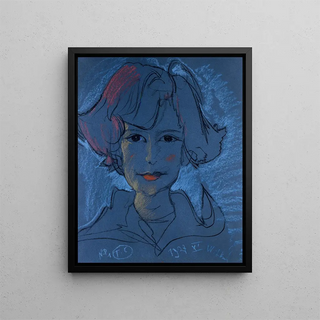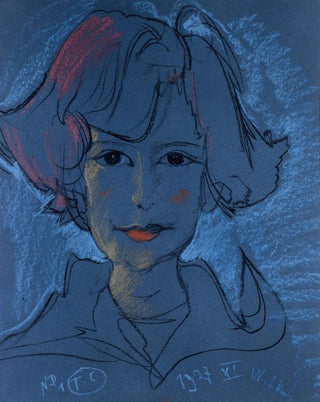Art print | Portrait of Anna Nawrocka - Stanisław Ignacy Witkiewicz


View from behind

Frame (optional)
Reproduction Portrait of Anna Nawrocka - Stanisław Ignacy Witkiewicz – Captivating Introduction
The "Portrait of Anna Nawrocka" by Stanisław Ignacy Witkiewicz is much more than a simple depiction of a female figure. It is a work that captures the very essence of the human soul, revealing both the beauty and complexity of its subject. This portrait, created in the early 20th century, reflects a period when art was breaking free from academic conventions to explore more personal and psychological dimensions. Anna Nawrocka, model and muse, is portrayed here with an intensity that transcends time, inviting the viewer to immerse themselves in a universe where each brushstroke tells a story.
Style and uniqueness of the work
Witkiewicz, known for his bold approach and unique style, manages to blend elements of realism and symbolism in this art print. The composition is characterized by a daring use of colors and shapes, creating an atmosphere that is both intimate and enigmatic. The features of Anna Nawrocka are accentuated by vivid nuances that seem to vibrate under the light, while the background, darker, highlights her presence. This contrast not only emphasizes the beauty of the model but also evokes deeper emotions, such as melancholy and contemplation. The way Witkiewicz captures Anna's gaze, both piercing and dreamy, invites the viewer to question her thoughts and feelings, making the work particularly immersive.
The artist and his influence
Stanisław Ignacy Witkiewicz, an emblematic figure of Polish art, left an indelible mark on the artistic landscape of his time. Philosopher, playwright, and painter, he skillfully combined these disciplines to create a rich and varied oeuvre. His innovative approach influenced many contemporary artists and helped redefine the role of art in society. Witkiewicz firmly believed that art should be a reflection of the human soul, a means to explore the depths of the mind and emotions. In the "Portrait of Anna Nawrocka," this philosophy is brought to light, demonstrating

Matte finish

View from behind

Frame (optional)
Reproduction Portrait of Anna Nawrocka - Stanisław Ignacy Witkiewicz – Captivating Introduction
The "Portrait of Anna Nawrocka" by Stanisław Ignacy Witkiewicz is much more than a simple depiction of a female figure. It is a work that captures the very essence of the human soul, revealing both the beauty and complexity of its subject. This portrait, created in the early 20th century, reflects a period when art was breaking free from academic conventions to explore more personal and psychological dimensions. Anna Nawrocka, model and muse, is portrayed here with an intensity that transcends time, inviting the viewer to immerse themselves in a universe where each brushstroke tells a story.
Style and uniqueness of the work
Witkiewicz, known for his bold approach and unique style, manages to blend elements of realism and symbolism in this art print. The composition is characterized by a daring use of colors and shapes, creating an atmosphere that is both intimate and enigmatic. The features of Anna Nawrocka are accentuated by vivid nuances that seem to vibrate under the light, while the background, darker, highlights her presence. This contrast not only emphasizes the beauty of the model but also evokes deeper emotions, such as melancholy and contemplation. The way Witkiewicz captures Anna's gaze, both piercing and dreamy, invites the viewer to question her thoughts and feelings, making the work particularly immersive.
The artist and his influence
Stanisław Ignacy Witkiewicz, an emblematic figure of Polish art, left an indelible mark on the artistic landscape of his time. Philosopher, playwright, and painter, he skillfully combined these disciplines to create a rich and varied oeuvre. His innovative approach influenced many contemporary artists and helped redefine the role of art in society. Witkiewicz firmly believed that art should be a reflection of the human soul, a means to explore the depths of the mind and emotions. In the "Portrait of Anna Nawrocka," this philosophy is brought to light, demonstrating






